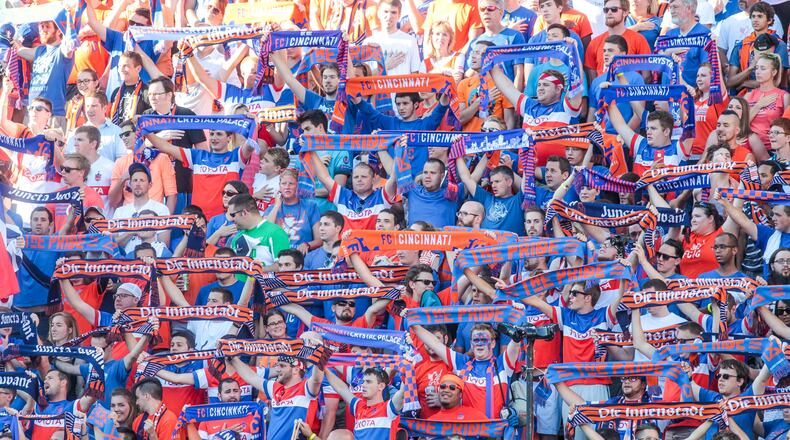»RELATED: Training complex to built in Milford
The club hopes to break ground on the site of Taft High School’s Stargel Stadium – which will be rebuilt across the street – by the end of this year with expectations to begin seeing foundations by the second quarter of 2019, celebrate a “topping out” by the end of 2020 and open the facility for play in 2021.
“When we first had the notion of bringing professional soccer to Cincinnati, we would hope a day like this would follow and the opportunity to announce a stadium project that would be an integral part of our community for generations to come,” FCC owner Carl Lindner III said. “… It’s been a winding road to reach this point but we’re excited about what’s going to be our new home in 2021. Our family has had a chance to be a part of many projects throughout our region, though I have to tell you, I’m ecstatic about a new MLS stadium for Cincinnati. It’s going to be awesome.”
»RELATED: MLS awards franchise to Cincinnati
»RELATED: Current players have big opportunity as FC Cincy joins MLS
The Machete Group will manage all phases of the stadium, Turner Construction will serve as the leading builder, while partnering with Jostin Construction, and the project will be financed by US Bank.
Turner has roots in Cincinnati since 1903 and is one of the nation’s largest sports builders with more than 450 stadium projects, including nearly half of all MLS stadiums.
“Our team assembled here represents the best in international design and construction with partners who know the local landscape and have gotten things done at a high level of excellence that meet our standards,” FCC President and General Manager Jeff Berding said. “Turner’s motto is ‘Build local, think global.’ I think that speaks perfectly to the team we have assembled.”
Architect Dan Meis, who designed the NFL Cincinnati Bengals’ Paul Brown Stadium, will continue working with the club on the designs, building off initial plans that were unveiled last June for the former Newport, Kentucky, site that was being considered along the banks of the Ohio River.
Meis still wants to implement fan plazas and keep an open concept that allows the community to feel connected to the stadium. However, he wants to tone down the glowing effect created by the ETFE material and use of LED lighting in the original plans.
“The club liked those early renderings from how spectacular it is and how you can control it and kind of turn the building on, so we are looking at the material still,” Meis said. “Probably in a different way and maybe not quite as over the top as that earlier design was because that was on an empty site with nothing really around it, so it was more of an object. There are some principals in that design that we’re going to bring to this, but we’re going to be very conscious of the community and not overpower it.”
Berding said the club wants the stadium to match the neighborhood in design and feel, but also should represent where the community is headed in the future. He still wants it to have a “wow” factor, but the size remains up in the air.
“You build what you can afford,” Berding said. “Right now, we are averaging about 25,000 fans, so 21,000 is probably the floor and 30,000 is probably the ceiling. There’s also value in scarcity, so you don’t want to build too big. We’re working with Turner on the costs of the project, and then we’ll see where we end up.”
About the Author
